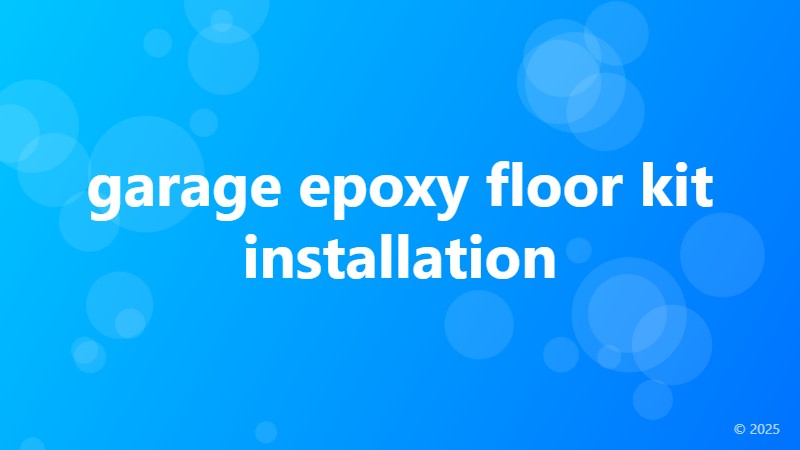garage epoxy floor kit installation
 ```html
```html
Choosing the Right Garage Epoxy Floor Kit
Transforming your garage floor from drab to fab is easier than you think with a garage epoxy floor kit. But with so many options available, choosing the right kit for your needs can feel overwhelming. This comprehensive guide will walk you through selecting the perfect kit, understanding the installation process, and ensuring a long-lasting, stunning finish. We’ll cover everything from understanding the different types of epoxy kits to troubleshooting common installation problems. So, let's dive in and get your garage floor project started!
Understanding Epoxy Floor Kit Types
Garage epoxy floor kits are available in a variety of formulations, each with its own set of advantages and disadvantages. Understanding these differences is crucial to selecting the best kit for your specific needs and budget. Common types include:
- 1-Part Epoxy Kits: These are generally easier to apply, requiring less technical expertise. They're a great option for DIYers, but might not offer the same durability as 2-part systems.
- 2-Part Epoxy Kits: These offer superior durability and resistance to chemicals and stains. They require more precise mixing and application, but the resulting finish is worth the extra effort for many homeowners.
- Epoxy Flake Kits: These kits incorporate colored flakes into the epoxy for a unique, textured finish. This provides added durability and hides minor imperfections in the concrete.
- Epoxy with Quartz Kits: Similar to flake systems, these kits utilize quartz for a more sophisticated and durable finish, often preferred for high-traffic areas.
Preparing Your Garage Floor for Installation
Proper preparation is key to a successful garage epoxy floor installation. A poorly prepared surface can lead to peeling, chipping, and an overall unsatisfactory finish. Follow these crucial steps before you even open your epoxy kit:
- Clean the Floor Thoroughly: Remove all dirt, grease, oil, and debris using a degreaser and a stiff-bristled broom or pressure washer. Allow the floor to dry completely.
- Repair Cracks and Holes: Fill any cracks or holes using a concrete patching compound. Allow it to cure completely according to the manufacturer's instructions.
- Etch the Concrete: Etching the concrete surface creates a better bond for the epoxy. Use a concrete etching solution following the product instructions carefully.
- Prime the Floor (if required): Some epoxy kits require a primer for optimal adhesion. Check your kit's instructions to determine if priming is necessary.
Step-by-Step Garage Epoxy Floor Kit Installation
Once your garage floor is properly prepared, you're ready for installation. While specific instructions will vary depending on the chosen kit, these general steps apply:
- Mix the Epoxy According to Instructions: Carefully follow the manufacturer's instructions for mixing ratios and times. Inconsistent mixing can lead to poor results.
- Apply the Epoxy: Use a notched trowel or roller to apply the epoxy evenly to the prepared concrete surface. Work in sections to avoid the epoxy setting before you can spread it properly.
- Broadcast Flakes or Quartz (if applicable): If your kit includes flakes or quartz, broadcast them evenly over the wet epoxy according to the manufacturer’s recommendations.
- Backroll (if necessary): Some kits require backrolling to ensure proper flake or quartz embedment and a smooth, even finish.
- Allow for Curing: Allow the epoxy to cure completely according to the manufacturer's instructions. This usually takes several days, and it’s crucial to avoid driving or walking on the floor during this time.
Troubleshooting Common Garage Epoxy Floor Kit Installation Issues
Even with careful preparation and application, you might encounter some issues. Here are some common problems and their solutions:
- Uneven Finish: This can be caused by improper mixing, uneven application, or insufficient preparation. Ensure thorough mixing and application, and consider using a leveling compound for severely uneven floors.
- Peeling or Chipping: This often indicates inadequate surface preparation or improper curing. Ensure the floor is clean, etched, and dry before application, and allow sufficient curing time.
- Air Bubbles: These can be minimized by using a de-aerator or slowly pouring and spreading the epoxy. Backrolling can also help to remove trapped air.
Maintaining Your New Epoxy Floor
Once your stunning new epoxy floor is installed, maintaining its beauty is relatively easy. Regular sweeping or vacuuming will remove dirt and debris. Occasional mopping with a mild detergent will keep your floor looking its best. Avoid using harsh chemicals or abrasive cleaners.
Conclusion
Installing a garage epoxy floor kit is a rewarding project that can dramatically improve the appearance and functionality of your garage. By following these steps and understanding the nuances of different kits, you can achieve a durable and beautiful finish that will last for years to come. Remember to always consult the specific instructions provided with your chosen kit for best results.
```